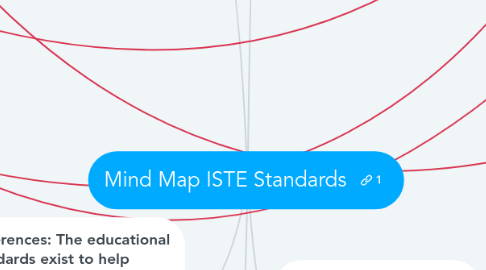Mind Map ISTE Standards
by Brynn Yoder

1. ISTE Standards for Educators
1.1. Learner: Educators continually improve their practice by learning from and with others and exploring proven and promising practices that leverage technology to improve student learning. Educators:
1.2. Leader: Educators seek out opportunities for leadership to support student empowerment and success and to improve teaching and learning. Educators:
1.3. Citizen: Educators inspire students to positively contribute to and responsibly participate in the digital world. Educators:
1.4. Collaborator: Educators dedicate time to collaborate with both colleagues and students to improve practice, discover and share resources and ideas, and solve problems. Educators:
1.5. Designer: Educators design authentic, learner-driven activities and environments that recognize and accommodate learner variability. Educators:
1.6. Facilitator: Educators facilitate learning with technology to support student achievement of the ISTE Standards for Students. Educators:
1.7. Analyst: Educators understand and use data to drive their instruction and support students in achieving their learning goals. Educators:
2. Differences: The educational standards exist to help educators help students to use technology in a way that allows them to become an active successful member of society.
3. Key: Red arrows connect similarities between educator and student standards
4. ISTE Standards for Students
4.1. Empowered Learner:Students leverage technology to take an active role in choosing, achieving, and demonstrating competency in their learning goals, informed by the learning sciences.
4.2. Digital Citizen:Students recognize the rights, responsibilities and opportunities of living, learning and working in an interconnected digital world, and they act and model in ways that are safe, legal and ethical.
4.3. Knowledge Constructor: Students critically curate a variety of resources using digital tools to construct knowledge, produce creative artifacts and make meaningful learning experiences for themselves and others.
4.4. Innovative Designer: Students use a variety of technologies within a design process to identify and solve problems by creating new, useful or imaginative solutions.
4.5. Computational Thinker: Students develop and employ strategies for understanding and solving problems in ways that leverage the power of technological methods to develop and test solutions.
4.6. Creative Communicator: Students communicate clearly and express themselves creatively for a variety of purposes using the platforms, tools, styles, formats and digital media appropriate to their goals.
4.7. Global Collaborator: Students use digital tools to broaden their perspectives and enrich their learning by collaborating with others and working effectively in teams locally and globally.
5. Differences: The student standards allow or help students to become independent within their educational experiences.


